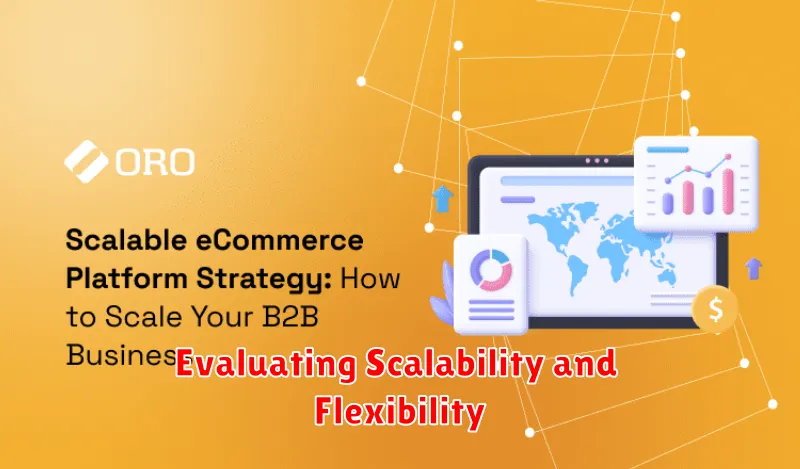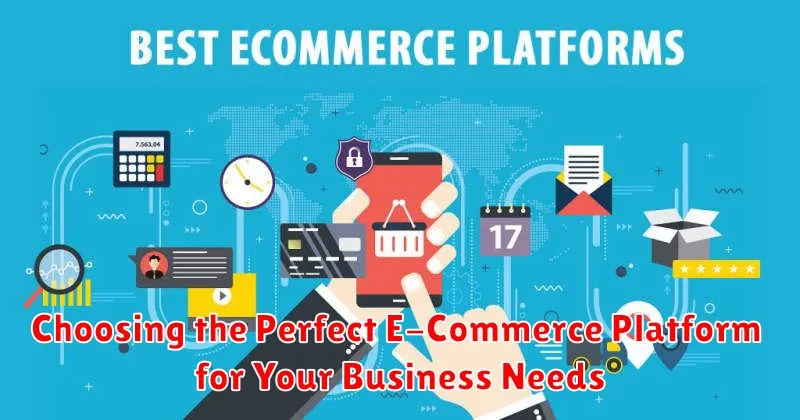Launching a successful online business hinges on choosing the right e-commerce platform. With a plethora of options available, navigating the landscape of e-commerce solutions can feel overwhelming. This article serves as your guide to selecting the perfect e-commerce platform tailored to your specific business needs. We’ll delve into the crucial factors to consider, from scalability and pricing to features and security, empowering you to make an informed decision that sets your business up for online success. Whether you’re a small startup or a large enterprise, understanding the nuances of each platform is essential for maximizing your online potential.
Finding the ideal e-commerce platform involves carefully evaluating your current and future business requirements. This includes analyzing your product catalog, target audience, budget, and growth projections. By understanding your unique needs, you can effectively compare different e-commerce platforms and pinpoint the solution that aligns with your business objectives. In the following sections, we will explore the key considerations that will guide you towards the perfect e-commerce platform, ensuring a seamless online experience for both you and your customers.
Understanding Your Business Requirements
Selecting the right e-commerce platform is crucial for your business’s success. Before evaluating different platforms, it’s essential to thoroughly understand your specific needs and requirements. This involves analyzing various aspects of your business operations.
Firstly, consider your product catalog. How many products will you be selling? Are there complex product variations (like size and color)? Do you require features like product bundling or subscriptions?
Next, evaluate your sales volume projections. A platform suitable for a small startup might not handle the traffic of a rapidly growing business. Think about your anticipated growth in the near future.
Target audience analysis is also key. Understanding your customer demographics will inform your platform choice. Consider features like multi-lingual support or specific payment gateways preferred by your target market.
Finally, assess your budget. E-commerce platforms range from free, open-source options to enterprise-level solutions with significant monthly fees. Factor in transaction fees, add-on costs, and potential development expenses.
Key Features to Look for in an E-Commerce Platform
Selecting the right e-commerce platform hinges on identifying key features that align with your business needs. Product Management capabilities should allow for easy listing, categorization, and updating of product information. A robust Inventory Management system is crucial for tracking stock levels, managing orders, and avoiding overselling.
Secure Payment Gateways are essential for processing transactions safely and efficiently. Look for platforms that offer multiple payment options and integrate with reputable payment processors. Customer Relationship Management (CRM) tools can help you manage customer data, personalize marketing efforts, and provide excellent customer service.
Marketing and SEO features are vital for driving traffic to your online store. Consider platforms that offer built-in SEO tools, email marketing integrations, and social media connectivity. A user-friendly Website Design and Customization interface empowers you to create a visually appealing and easy-to-navigate online store.
Exploring Popular E-Commerce Platforms
Several established platforms cater to diverse business needs. Understanding their strengths and weaknesses is crucial for making an informed decision.
Shopify
Shopify is known for its user-friendliness and extensive app store, making it a popular choice for beginners and growing businesses. It offers various pricing tiers to accommodate different budgets.
WooCommerce
WooCommerce, a WordPress plugin, provides greater flexibility and customization options for businesses comfortable with managing a website. It’s an open-source platform, offering a wide range of free and paid extensions.
Magento
Magento, an Adobe product, is a robust platform suitable for larger enterprises with complex requirements. Its scalability and advanced features come with a steeper learning curve and higher costs.
BigCommerce
BigCommerce, similar to Shopify, offers a comprehensive suite of tools for managing online stores. It’s particularly well-suited for businesses focused on rapid growth and multi-channel selling.
Squarespace
Squarespace provides an all-in-one platform for building websites, including e-commerce functionality. Its focus on design and simplicity makes it appealing to businesses prioritizing aesthetics and ease of use.
Evaluating Scalability and Flexibility

As your business grows, your e-commerce platform needs to keep pace. Scalability refers to the platform’s ability to handle increasing traffic, sales, and product listings without performance issues. Consider your projected growth and ensure the platform can accommodate it.
Flexibility is crucial for adapting to changing market demands and business strategies. A flexible platform allows you to easily customize your online store, add new features, and integrate with other business tools. Think about your future needs and choose a platform that can evolve with your business.
Key aspects of scalability and flexibility to consider include:
- Traffic Capacity: Can the platform handle traffic spikes during peak seasons or promotions?
- Product Capacity: Can it accommodate a growing product catalog?
- Integration Options: Does it integrate with essential business systems like CRM, inventory management, and marketing automation platforms?
- Customization Options: Can you tailor the platform to meet your specific branding and functionality requirements?
Considering Pricing and Payment Options
Choosing an e-commerce platform requires careful consideration of pricing and payment options. Platform fees can vary significantly, from monthly subscriptions to transaction fees and usage-based pricing. Understanding these costs is crucial for budgeting and profitability.
Payment gateway integration is another critical factor. The platform should seamlessly integrate with popular payment gateways like PayPal, Stripe, and Square, offering customers a variety of payment methods. Consider transaction fees charged by these gateways as part of your overall cost assessment.
Think about additional expenses like premium themes, plugins, or extensions that might enhance your online store’s functionality. While these can improve the customer experience, they can also add to your overall costs. Factor these potential costs into your platform selection.
Assessing Security and Compliance Features
Security is paramount when choosing an e-commerce platform. Protecting customer data and ensuring secure transactions should be a top priority. Look for platforms that offer robust security features like SSL certification, PCI DSS compliance, and fraud prevention tools.
SSL certificates encrypt data transmitted between the customer’s browser and your website, safeguarding sensitive information. PCI DSS compliance demonstrates that the platform adheres to strict security standards for processing credit card payments. Fraud prevention tools help identify and mitigate potentially fraudulent transactions, minimizing financial risks.
Compliance with relevant regulations is also crucial. Depending on your industry and location, you might need to consider regulations like GDPR, CCPA, or other data privacy laws. Ensure the platform you choose helps you meet these requirements. Carefully evaluate the platform’s security and compliance features to build trust with your customers and protect your business from potential threats.
Prioritizing User Experience and Design
A seamless and enjoyable user experience is crucial for e-commerce success. Your chosen platform should prioritize intuitive navigation, a clean layout, and mobile responsiveness.
Consider the following aspects of UX/UI design:
- Navigation: Is it easy for customers to find what they’re looking for? A well-organized product catalog and search functionality are essential.
- Mobile Optimization: With the majority of online shopping happening on mobile devices, a responsive design is non-negotiable. Test the platform on various screen sizes.
- Checkout Process: A streamlined and secure checkout experience minimizes cart abandonment. Look for features like guest checkout and multiple payment options.
- Customization: Can you tailor the look and feel of your online store to match your brand? Consider the platform’s theming options and flexibility.
Integrating with Existing Business Tools
A crucial aspect of selecting an e-commerce platform involves its ability to seamlessly integrate with your current business tools. This integration streamlines operations and maximizes efficiency.
Consider which tools are essential for your business. These could include Customer Relationship Management (CRM) systems, email marketing platforms, inventory management software, or accounting solutions. A platform that integrates well with these tools eliminates data silos and manual data entry, saving time and reducing errors.
Examine the platform’s API (Application Programming Interface) and available integrations. A robust API allows for custom integrations if pre-built options don’t meet your specific requirements. Check for direct integrations with popular tools or the availability of middleware solutions that can bridge the gap.
Think about your future needs. As your business grows, your toolset might expand. Choose a platform that offers scalability and flexibility in its integrations to accommodate future growth.
Making the Right Choice for Your E-Commerce Success

Selecting the right e-commerce platform is a pivotal decision for your business. A well-chosen platform can significantly contribute to growth and efficiency, while a poor choice can hinder your progress. The ideal platform aligns with your specific business needs and goals, both current and future. This requires careful consideration of several factors.
Scalability is paramount. Your chosen platform should accommodate growth without requiring a complete overhaul. Consider your projected sales volume, product expansion, and potential market reach. Choose a platform that can adapt to these changes seamlessly.
Budget is another crucial factor. Evaluate the total cost of ownership, including subscription fees, transaction fees, and potential development costs. Balance affordability with the features and functionality necessary for your business model.
Finally, vendor support plays a vital role in your success. Look for platforms offering robust technical support, comprehensive documentation, and a responsive community. A reliable support system can help you navigate challenges and maximize the platform’s potential.

